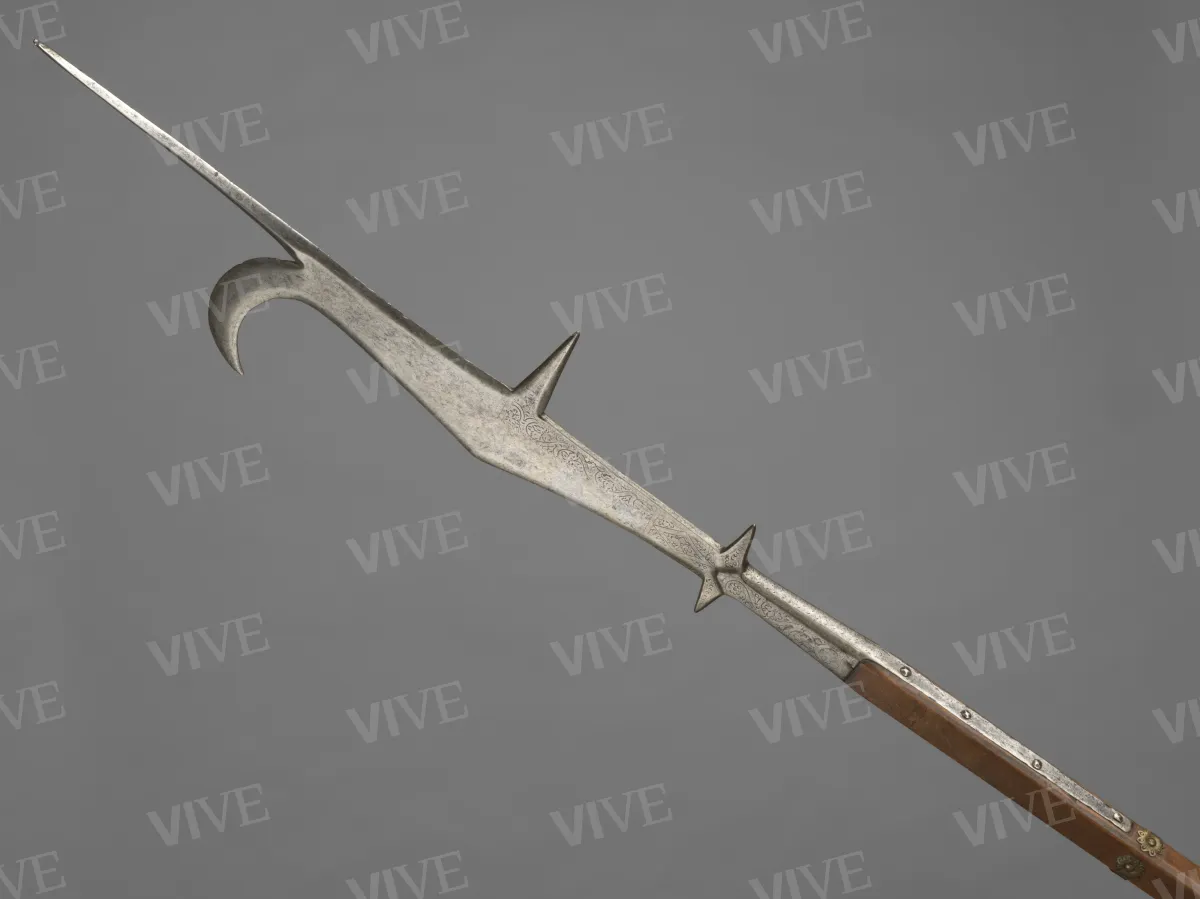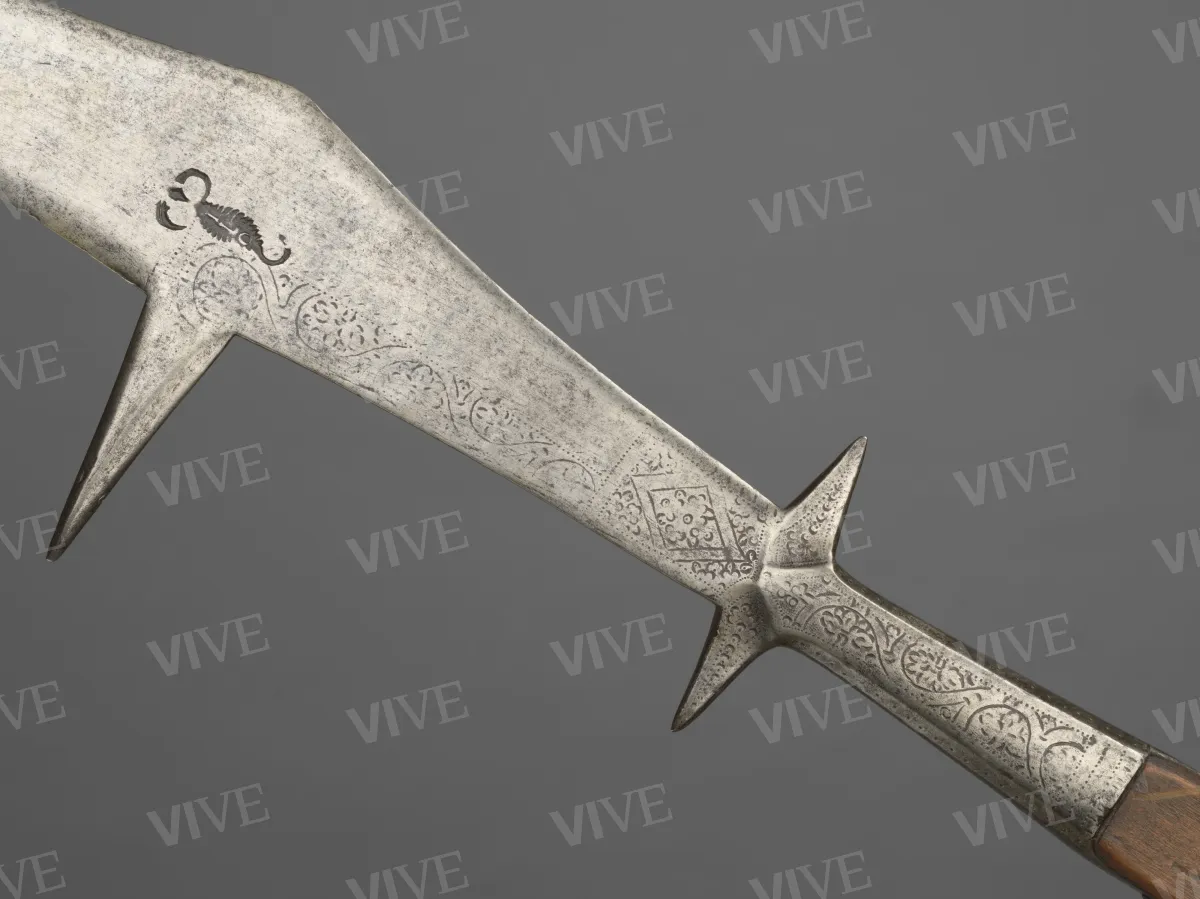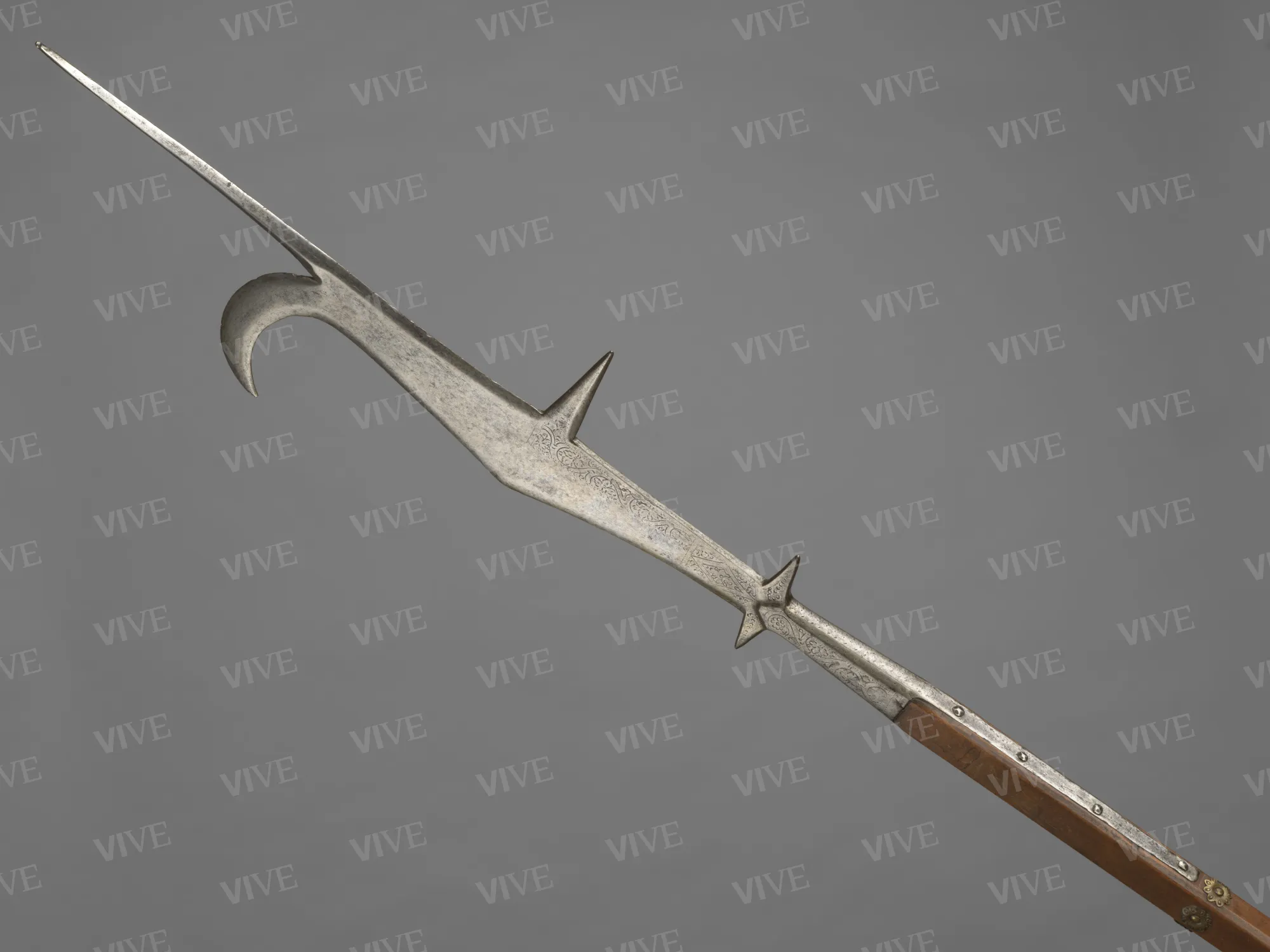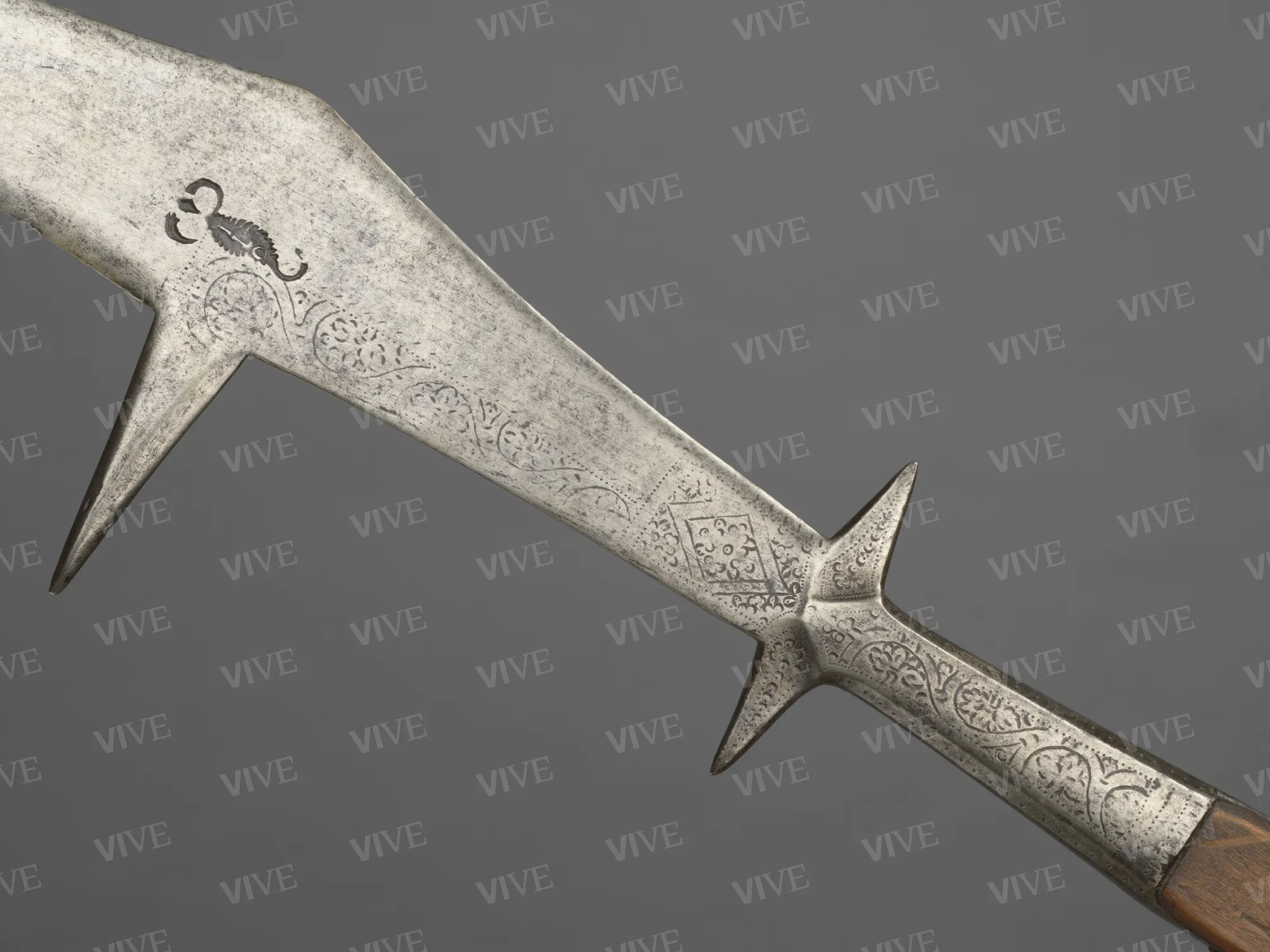Roncone (polearm)
Milanese production 1480–1530
This roncone, a type of polearm mounted on a long wooden shaft, features a metal section decorated with engravings of plant and geometric shapes. Near the catch, it bears the mark of a scorpion, which is associated with a Milanese workshop active during the fifteenth and sixteenth centuries. Originally used for agricultural purposes, the roncone transitioned into a versatile bladed weapon by the fourteenth century, serving both to hook the enemy and strike with its blades.
This roncone, a type of polearm mounted on a long wooden shaft, features a metal section decorated with engravings of plant and geometric shapes. Near the catch, it bears the mark of a scorpion, which is associated with a Milanese workshop active during the fifteenth and sixteenth centuries. Originally used for agricultural purposes, the roncone transitioned into a versatile bladed weapon by the fourteenth century, serving both to hook the enemy and strike with its blades.
Details of work
Catalog entry
The roncone is attached to a long wooden pole using eight nails, with four on each side, and a copper flower-shaped stud. The metal part includes a long cusp with a square cross-section, a semi-circular arched spur, a pointed notch halfway up the back, and two points at the beginning of the hook where it connects to the rod. The metal part, from the two points to the tooth, features engravings on both sides with intertwined plant and geometric designs, and in the center, the mark of the weapons maker is visible, showing a scorpion (di Carpegna 1969, p. 62, n. 370; di Carpegna 1976, p. 62).
The roncone, also referred to as a ronco, is a pole-mounted weapon that evolved from a billhook, a tool commonly used in agriculture, particularly for tending to fruit trees. From the thirteenth century onwards, it was also employed as a weapon. Forged as a single piece, occasionally decorated but more often plain, the roncone was utilized for stabbing opponents. Its curved blade allowed for hooking and dismounting knights, and it served as an effective tool during naval battles for hooking the sides or cutting the rigging of enemy ships. This weapon saw widespread use across Europe during the sixteenth century (Troso 1988, pp. 135–285; Waldman 2005, pp. 115–123; Oakeshott 2012, p. 51).
This example features the scorpion mark used by Milanese gunsmiths since the mid-fourteenth century, when it was cited as “unum ense operis Lombardie, ad signum scorpionis” (document dated 1365 cited in di Carpegna 1969, p. 62, n. 370). This symbol was then customized by various weapons makers with a few letters, likely the initials of their names, such as “ILO,” which appears in an almost identical example in the Wallace Collection in London (inv. A932) and others in the Philadelphia Museum of Art (Kienbusch collection, no. 543) or the Museo Civico Marzoli in Brescia (inv. 417). This brand appeared on products of some fifteenth-century Lombard knife makers, to whom the creation of this large knife can also be attributed (Waldman 2005, pp. 67–69; Scalini 2018, p. 131, n. IV.8).
The weapon is part of the collection of Prince Ladislao Odescalchi (1846–1922), purchased by the Italian State in 1959 and placed in Palazzo Venezia in 1969. This extensive collection was not a family armoury but was formed through targeted purchases from national markets, such as Florence and Rome, and international markets, such as Paris and London, beginning in the late nineteenth century, reflecting Odescalchi’s personal taste (Barberini 2007).
Giulia Zaccariotto
Entry published on 27 March 2025
State of conservation
Good.
Coats of arms, emblems, and marks
The trigger guard features the weapon manufacturer's mark, which is a scorpion accompanied by the vertically arranged letters “ILO.”
Provenance
Collezione Ladislao Odescalchi (Odescalchi, no. 1531);
Rome, acquired by the Italian State, 1959;
Rome, Museo Nazionale di Palazzo Venezia, 1969.
Exhibition history
Rome, Museo Nazionale di Palazzo Venezia, Antiche armi dal sec. IX al XVIII. Già Collezione Odescalchi, May–July 1969;
Rome, Museo Nazionale di Palazzo Venezia, Belle e terribili. La collezione Odescalchi. Armi bianche e da fuoco, December 18, 2002–March 23, 2002;
Rome, Museo Nazionale di Castel Sant’Angelo; Rome, Museo Nazionale di Palazzo Venezia, Armi e potere nell’Europa del Rinascimento, July 26–November 11, 2018.
References
di Carpegna Nolfo (a cura di), Antiche armi dal sec. IX al XVIII. Già Collezione Odescalchi, catalogo della mostra (Roma, Museo Nazionale di Palazzo Venezia, maggio-luglio 1969), con schede a firma del curatore, Roma 1969, p. 62, n. 370;
di Carpegna Nolfo, Le armi Odescalchi, Roma 1976;
Troso Mario, Le armi in asta delle fanterie europee 1000-1500, Novara 1988;
Barberini Maria Giulia (a cura di), Belle e terribili. La collezione Odescalchi. Armi bianche e da fuoco, catalogo della mostra (Roma, Museo Nazionale di Palazzo Venezia, 18 dicembre 2002-23 marzo 2002), Roma 2002, p. 35;
Waldman John, Hafted Weapons in Medieval and Renaissance Europe: The Evolution of European Staff Weapons between 1200 and 1650, Leiden 2005;
Barberini Maria Giulia, La collezione Odescalchi di armi antiche: storia della raccolta del principe Ladislao, in «Bollettino d’arte», s. VI, XCI, 2006 (2007), 137/138, pp. 101-114;
Fossà Bianca, Studio conservativo delle armi e armature Odescalchi. Nuove metodologie per la schedatura di una collezione, in «Bollettino d’arte», s. VI, XCI, 2006 (2007), 137/138, pp. 115-142;
Oakeshott Ewart, European Weapons and Armour. From the Renaissance to the Industrial Revolution, Woodbridge 2012;
Scalini Mario (a cura di), Armi e potere nell’Europa del Rinascimento, catalogo della mostra (Roma, Museo Nazionale di Castel Sant’Angelo; Roma, Museo Nazionale di Palazzo Venezia, 26 luglio-11 novembre 2018), con schede a firma del curatore, Cinisello Balsamo 2018, p. 131, n. IV.8.














